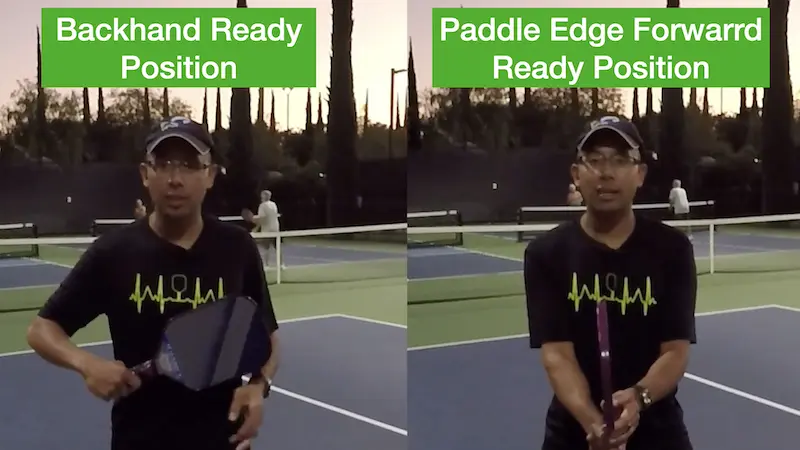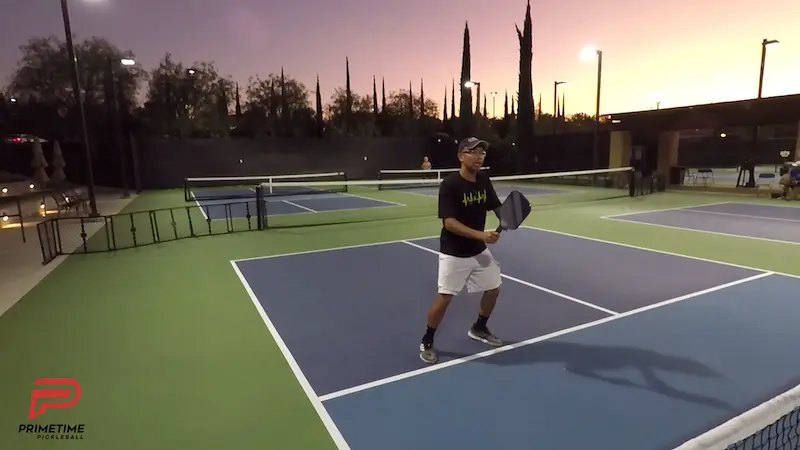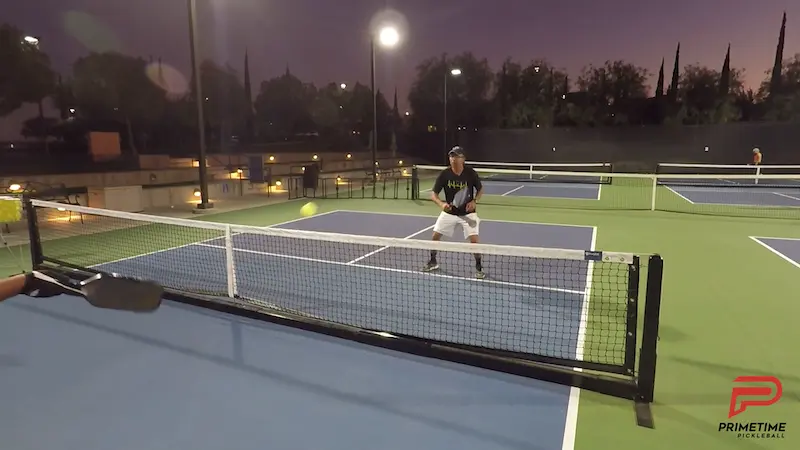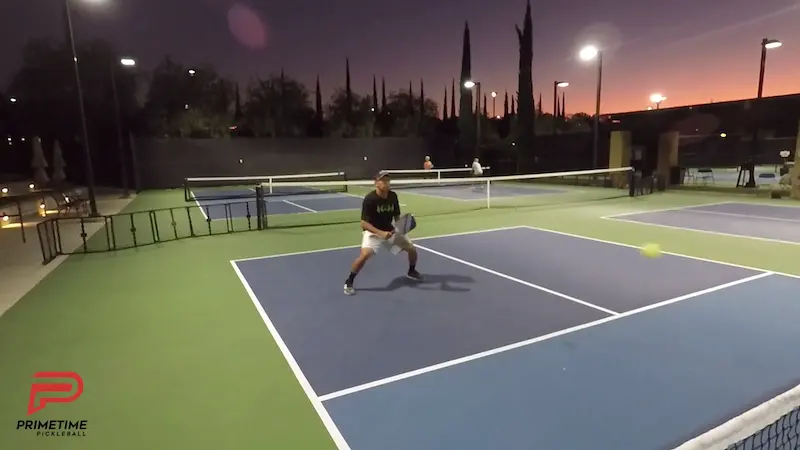In the today’s blog, we’re going to talk about the pro ready position at the net.
You might have heard a lot about this topic. There are different points of view of where to set your paddle and what the correct ready position is at the non-volley zone.
We’re going to talk a little bit about that today. Hopefully to clear up some uncertainties and to give you a clearer answer.
There’s really two extremes when it comes to the ready position at the net.
The first one is the full backhand. Your paddle is parallel to your torso, parallel to your chest.
The other one that’s the full extreme is going to be where the paddle is facing your opponents. The edge guard is facing directly to them.
We rarely have our paddle in both those extremes. We’re usually somewhere in the middle and that really depends on the situation.
Let’s talk about why these two extreme positions are taught and what are the pros and cons of them.
The first one, which is all the way extreme to the backhand side, is really good because if your opponents are attacking straight at your body, and anywhere around your body, this is a good position to defend in.
The reasoning behind this is that you are ready to block anywhere around your body. Let’s say from your chest area to your thighs and around that general body span.
For the second position, where your paddle is facing in front if you, it can be really good because you have an equal opportunity to get ready to hit a backhand or to get ready to hit a forehand.

If you’re in the first position where you paddle is on the extreme backhand side and they send you a forehand you’re going to have to come way over to the forehand really quickly to get that.
There are three different things that we think about when we’re deciding what paddle position to use and which one we’re going to go with.
Thought #1 – Are You On The Offense Or On The Defense?
Number one, are you on the offense or the defense in that particular time in the point?
Personally, most of the time when we’re on the defense, we tend to favour our backhand because it’s just a higher success rate for us to block those shots.
If we’re playing the defense and we know our opponent is attacking us and maybe trying to back us off the line, we’re going to favour the backhand position. This way, we can block and we could defend ourselves.
If we’re on the offense, we’re attacking out opponents and we’re leaning over the line. We know out next shot might be a put away.
After sending the ball over we’re going to set our paddle ready positions so the paddle edge if facing our opponents so that we can get ready for a forehand or backhand.

To sum it up, if you’re on the on the defense you should be more towards your backhand and if you’re on the offense, at that particular time of the point, yourpaddle position should be pointing straight ahead.
Thought #2 – How Close/Far Are The Opponents?
The second thing that we think of is where are my opponents and how close or far are they from us.
If we’re at the non-volley zone and they’re back, we’re not really on the defense. We’re kind of in an offensive positioning. If they’re back we have a long time for that ball to get to us compare to if they were at the non-volley zone.
Whether they’re going to drive it or drop it we’re gong to have our pad facing straight ahead. This way we can be ready to hit a forehand or a backhand.
So, the distance between you and your opponents plays a big factor on our paddle position and it should on yours as well.
The closer that your opponents, the more you should favor your backhand side a little bit to play some defense just in case they speed up the ball.

If they’re further back, you have time to react so your paddle can be facing in front of you. That way you could get a forehand put away or a backhand put away if you need to.
Thought #3 – Is The Ball Coming From Straight Ahead Or Cross Court?
The third thing we want you to think about is where your opponents are hitting the ball from.
If they’re striking the ball right in front of us down the line, this means we have less time to react to that ball. If that’s the case we have to be ready for a speed-up shot and in this case we might favour our backhand ready position a bit more.
But if your opponent is cross court and we’re outside to odd side, and if they’re hitting that ball from over there’s a potential that they can hit a ball to the middle.
They can either drive it to the middle or dink to the middle. In this case it doesn’t make sense for us to be in this backhand ready position if a lot of the put away shots or the sped up shots are going to be on our forehand.
In this situation, we’re going to be in more in the paddle forward position so we could be ready to attack and be aggressive on our forehand side.
But, like we said earlier, if they’re hitting the ball straight on we have to be more ready for an attack from our opponent so we’re going to make sure that we’re leaning more towards a backhand.
Now you know it’s not really a concrete answer. Our ready position is not always going to be in this extreme backhand position and it’s not always going to be in this forward position with our edge guard facing our opponents.
We’re always thinking about these three things.
First, are we on the offense or the defense?
Second, how far are we from our opponent? What’s our reaction time like?
Third, where’s the ball being hit from? Is it being hit cross-court from us or in front of us?
Those are all factors that are going to weigh in on how we position our paddle.
If you’re stuck transitioning to the non-volley zone or getting pushed back in to no-man’s land we recommend you have your paddle in forward ready position where your paddle edge if facing your opponents.

We say this because you’re a little further back and your opponent could hit at your feet towards the right or left foot.
If your paddle is in the backhand extreme ready position it will be hard for you to flip to that forehand real quick to defend an attack on your right foot.
However, if you’re really on defense and you know your opponent has been attacking you at the body, you may want to lean towards your backhand ready position.
Based on those three things, try to be more mindful of where your paddle is and remember it’s not always one way. A certain ready position is no always the right way.
You’re going to adjust depending on where the ball is and those other factors we discussed.
You’re going to adjust where you want to actually place your paddle and what kind of ready position you’re going to want to use.